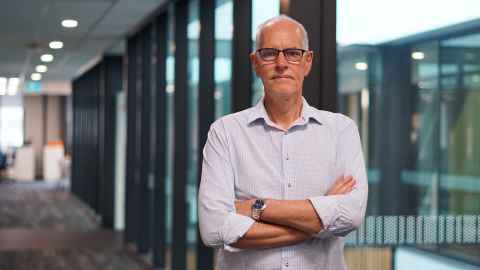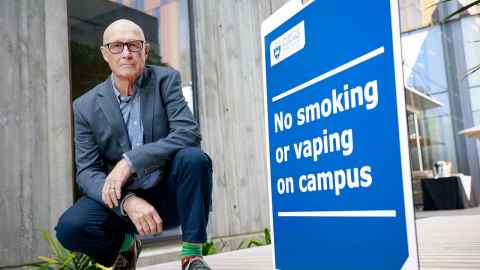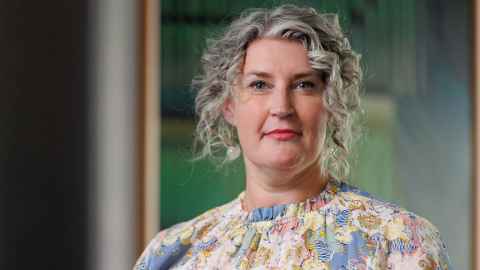Up in smoke: standing up for smokefree legislation
24 May 2024
Earlier this year, the new government dismantled changes to New Zealand’s groundbreaking smokefree legislation. Donna Chisholm meets University of Auckland experts determined to see it reinstated.

University of Auckland Professor in Public Health Chris Bullen says he was almost shocked speechless by the government’s recent changes to New Zealand’s smokefree laws.
“I could hardly speak for two days I was so livid,” says Chris, who joins a raft of academics and physicians condemning the move, which dismantled New Zealand’s world-leading legislation to denicotinise tobacco, prohibit cigarette sales to those born after 1 January 2009, and drastically reduce outlets.
That reaction was shared by Boyd Swinburn, professor of population nutrition and global health, who described the move as “jaw dropping”.
“It took a long time to sink in that these guys actually mean this; that they have been got to and are doing the tobacco industry’s job. They’re shameless about it and they’re not going to listen to the evidence or public opinion and have just ram-raided it through.”
Since then, however, actions have replaced words as they push for a reinstatement of the laws, introduced last year to global acclaim.
Tobacco is basically a defective product.
Heading the moves is Health Coalition Aotearoa, which Boyd co-chairs and on which Chris also serves as a member of its Smokefree Expert Advisory Group.
The group is working on a possible citizens-initiated referendum to reinstate the legislation that the new government repealed under urgency as part of its 100-day plan. The law change was part of the National Party’s agreement with coalition partners New Zealand First and ACT.
It’s a high bar to reach – requiring 380,000 signatures, which have to be collected on paper rather than electronically. Boyd describes this as a legacy of law around citizens-initiated referenda, which was written in the 1990s, and requires “a total military exercise” in planning and execution.
While only $50,000 can be spent on advertising, at least that amount again will be required to coordinate the project and to pay for other expenses, such as legal advice.

That will likely take a couple of years, says Boyd, so it’s possible the referendum question wouldn’t go to the public before the 2026 general election. By then, they say, thousands more smokers will have died, despite smoking rates falling to unprecedented lows.
New Zealand’s smoking rate stands at 6.8 percent, although that doesn’t apply across the board, with Māori smoking levels much higher, at 17.1 percent.
But with only one percent of those aged 15 to 17 using cigarettes now, won’t smoking become a thing of the past, anyway?
Eventually, yes, say Chris and Boyd, but not soon enough, and those statistics aren’t a reason to do nothing.
Without the interventions, Boyd reckons it will be 2060 before New Zealand’s rates drop below five percent for all ethnic groups. In the meantime, up to 5,000 people a year are dying of smoking-related illnesses.
“Saying we’re chugging along okay, so let’s put up with thousands more deaths just because we seem to be heading in the right direction… no. We have to accelerate that decline using what powers we have.”

Professor Paula Lorgelly, from the School of Population Health, holds a chair in health economics at the University. She says from a health economics point of the view, the government’s decision is shortsighted.
“Excise duties on tobacco raise revenue for the government’s budget, and a smokefree Aotearoa will have less government revenue from these duties. But we also need to factor in lower health expenditure as we reduce tobacco-related illnesses, and more income and income tax by avoiding illness and early death.
“Big business is being put ahead of people’s health,” says Paula.
A recent Newsroom story in fact pointed to independent analysis, published in November last year, which found that while the government would experience a $17 billion loss out to 2050 as a result of the 2022 legislation, this would be offset by a vastly larger $46 billion economic benefit over the same period.
The story noted that health officials briefed Associate Health Minister Casey Costello, who oversees tobacco control, about the research outlining the legislation’s economic benefits, but this wasn’t passed on to Cabinet when the minister proposed repealing the reforms.
The briefing also largely backed up Boyd’s 2060 date for achieving the target of a five percent smoking rate for all population groups in the absence of the smokefree legislative changes; health officials noted this wouldn’t be reached until 2061.
Big business is being put ahead of people’s health.
Chris says that with the law changes introduced by the Labour Government, the country might have “sneaked in” to reach the target around 2027. The Smokefree 2025 slogan was always just that, rather than an achievable target, but the three policy planks were vitally important.
“Tobacco is basically a defective product, and it’s highly addictive,” says Chris.
“Imagine a government being okay with a vehicle on the road which has a fundamental flaw and over its lifetime of use, half the people who drive it were at risk of dying in a major crash. Imagine if the government turned a blind eye and continued to allow those vehicles to be sold.”
The laws were about locking in protection for future generations, he says, adding that it’s not guaranteed that smoking in young people will continue to decline. Australia, for example, has just seen an uptick in smoking rates for the first time in 25 years. Although Australia has largely the same policy settings as New Zealand, its vaping laws are different. It legislates nicotine as a poison and vapes are available only via a GP’s prescription or the black market.
In 2018, just over two percent of Australians aged 14 to 17 smoked cigarettes, but that increased to nearly 13 percent by March 2023. In the same cohort, vaping rates increased from one percent to more than 14 percent.
If everyone who took up vaping did so with the intention of ultimately giving up vaping and never going back to smoking that would be a brilliant public health success story, says Chris. “Unfortunately, people are taking it up when they didn’t smoke, and that’s a problem.”
The rise in vaping is a particular concern for Associate Professor Kelly Burrowes, a researcher at the Auckland Bioengineering Institute, who worries that the long-term health effects – which may not be as dire as smoking – are largely unknown.
“I do think there is a place for vaping, for people to switch from smoking, but an unexpected consequence has been the huge uptake among people who didn’t smoke.”

This includes her own husband, who’d given up smoking 14 years earlier before moving to nicotine patches and gum but wasn’t using anything when he began vaping a few years ago.
She’d like to see fewer shops selling vapes and the eradication of flavours, which encourage younger people to vape. She says a US study that surveyed about 1,400 young people found that 70 percent said they would stop vaping if they could buy only tobacco-flavoured vapes.
Kelly’s research involves testing the chemicals in e-liquids and aerosols and has found at least 40 different chemicals used to create flavour, and some heavy metals off the vape itself. She and her team are studying the effect of vape aerosols on lung cells grown in the lab.
An unexpected consequence [of vaping] has been the huge uptake among people who didn’t smoke.
Although most of the publicity about the tobacco law changes in recent months has been on the loss of the ‘smokefree generation’, Chris and Boyd believe the move to denicotinisation had the greatest potential to change smoking habits, because it could eliminate addiction to the product – if not to smoking behaviour.
“If I were to invest in one strategy only, it would be denicotinisation, because it’s highly likely to lead to a massive drop in smoking prevalence across all population groups rapidly,” says Chris. “It takes out the addictive component and not just on theoretical grounds – it has been shown to be effective in large randomised controlled trials here, and in the US and other countries. People lose interest when they can’t get the nicotine.”
He believes the government’s response that denicotinising tobacco was an unproven strategy is incorrect. The US Food and Drug Administration had said it wanted to start regulating nicotine in tobacco and was looking to New Zealand to learn how to do that.
“When it suits the government to say there is not enough evidence, you say ‘what evidence do you need?’, and they’ll say ‘let’s see another country do this’. It needs a first country to make the move, and New Zealand was going to be that country.”
As the pair push ahead with their plans, they’re mourning the loss of the groundbreaking laws that had made New Zealand a world leader in the field.
“It was groundbreaking, end-game stuff,” says Boyd, “and this is why the tobacco industry gives a shit about New Zealand, not because of the numbers of smokers – they couldn’t care less if New Zealand became smokefree because we are just a tiny speck of the market. It’s the model we show to others. They do not want the first domino to fall.”
This article first appeared in the Autumn 2024 edition of Ingenio.